Aggressor aircraft launched an assault against HMS Queen Elizabeth and her Carrier Battle Group near the Moray Firth, the purpose is for the task force to practice defending against air attack.
Hawk jets and other aircraft, some operated by Cobham, have been simulating air attacks against the Carrier Battle Group.
Typically, Hawk jets support Dassault Falcon 20DC aircraft acting as long-range anti-ship bombers. The Falcons are flown by Cobham Aviation Services.
Current #UK #ADSB map shows #JW202 activity taking place off the #MorayFirth this is the aggressor force courtesy of @Cobham_plc other assets in the area are operating under combat conditions and have digital idents switched off & using secure comms #avgeek #osint #planespotting pic.twitter.com/8050o5yquI
— 🏴ScotMilAir (@mil_scot) October 6, 2020
HMS Queen Elizabeth and her Strike Group are currently exercising alongside allied nations in the North Sea, as part of NATO’s largest annual exercise, Joint Warrior.
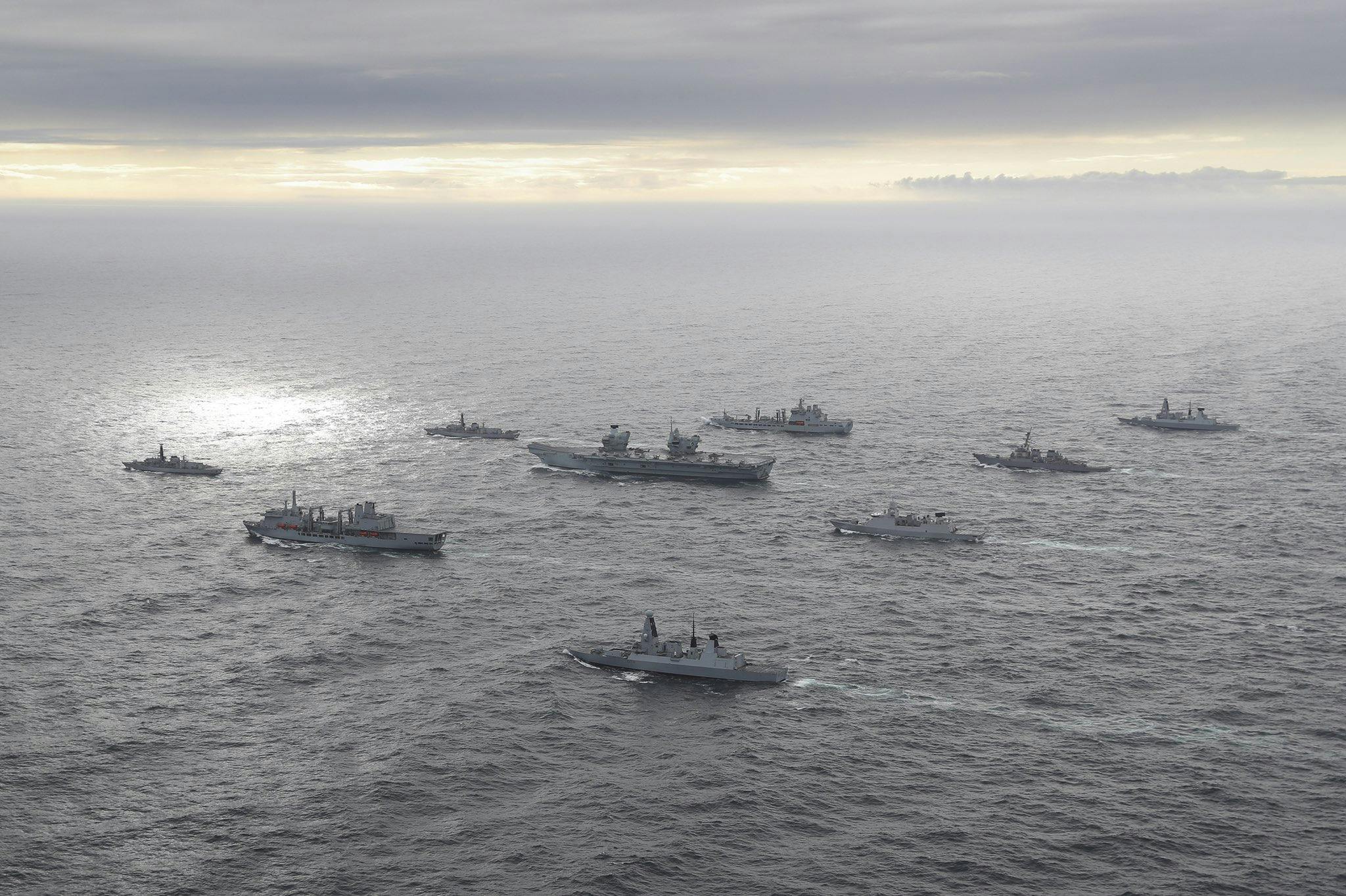
The Ministry of Defence say that the aim is to provide a complex environment in which the participants can train together, honing tactics and skills in preparation for deployment as a Combined Joint Task Force.
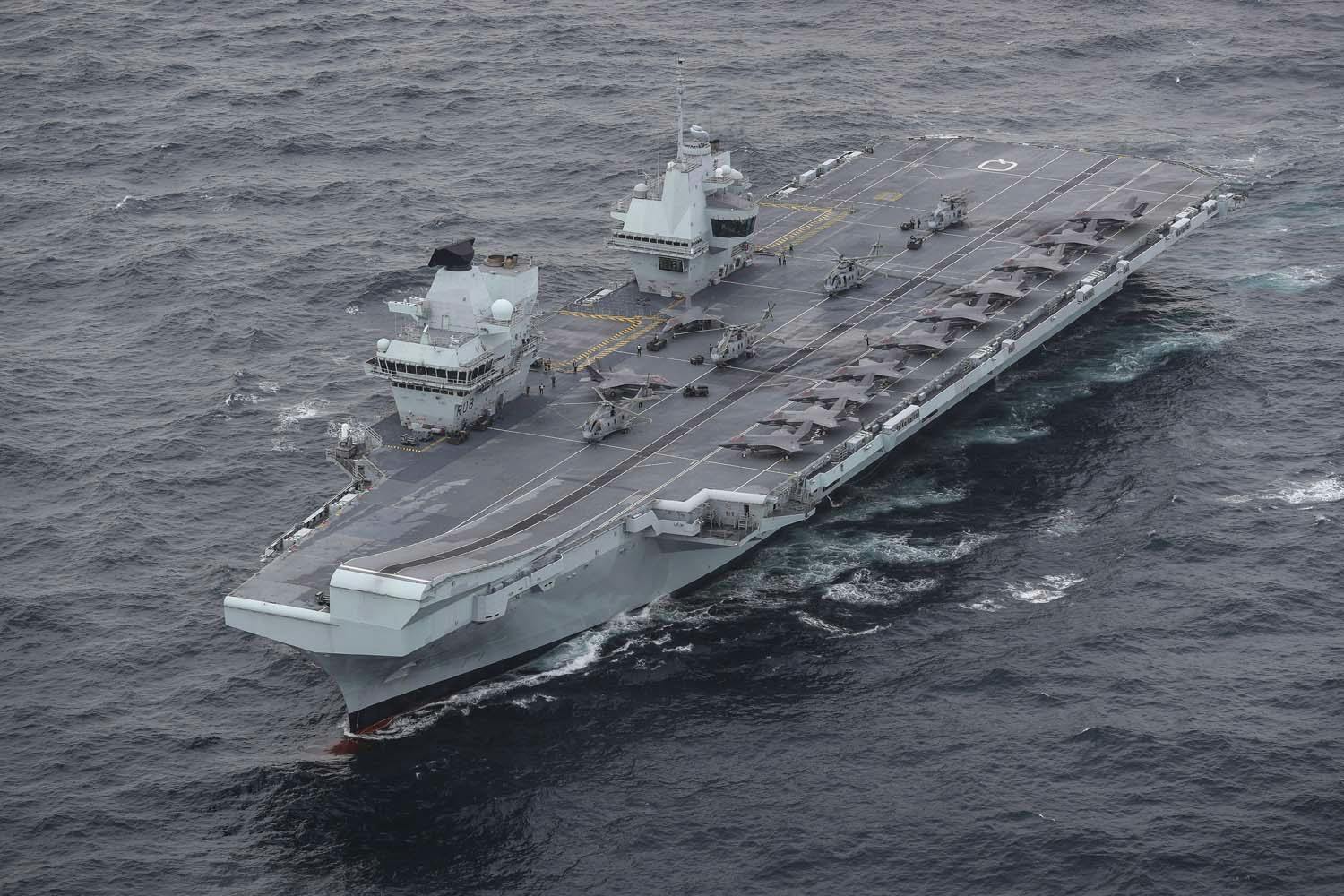
“The scenario for each Joint Warrior is designed to reflect contemporary political tensions – such as the War on Terror and the threat posed by ISIS – and to simulate the hostilities that might result from them. The ultimate aim? To assure maximum preparedness in the face of any threat.”

This massive multinational war exercise involves warships, aircraft, marines and troops from UK, NATO and allied forces. The exercise doesn’t only allow participating units to hone their specialist roles within a larger war-style setting – it also helps foster vital links between the UK, NATO and other allied militaries.
A similar event happened last month when French Rafale jets launched an assault against Royal Navy flagship HMS Albion as her task group passed the Brittany peninsula to allow French pilots to practise their anti-ship tactics and the Royal Navy to practice defending against air attack.
According to the Royal Navy in a news release at the time, Albion is leading the Littoral Response Group (Experimentation) deployment, comprising destroyer HMS Dragon, amphibious support ship RFA Lyme Bay and elements of 3 Commando Brigade.
“The ships are on a three-month deployment to the Mediterranean to test the concepts, equipment and practicalities of the Future Commando Force, as well as conducting traditional exercises and operations with NATO and other allies and partners in the region. Passing Brittany brought the group well within range of the Rafales, based at Landivisiau Naval Air Station near Brest when they’re not embarked as the striking power of France’s flagship, carrier FS Charles de Gaulle.
And lifting off from Lann-Bihoué air base on the outskirts of Lorient was an E-2 Hawkeye airborne early-warning and control aircraft, which spent a few hours looking for the naval group. When the Hawkeye’s crew located the shipping, they directed the Rafales in to make their attack runs, coming in with the sun at their backs – a classic fighter tactic. As the aircraft were detected, Albion’s Combined Operations Room burst into a flurry of controlled activity. Systems hummed and headsets buzzed as sailors responded to the growing threat.
In theory Dragon and her Sea Viper missiles should take out incoming jets – or any rockets they fire – at long range. Should that fail, the task group has numerous automated Phalanx Gatling guns which spew out a supposedly-impenetrable wall of lead up to around one kilometre from each ship, decoys and, as a last resort, hand-operated machine-guns and SA80 rifles. Both sides were able to test their attacking and defensive tactics and manoeuvres during the successive waves of raids.”
You can read more about the deployment of HMS Albion and her task group here.


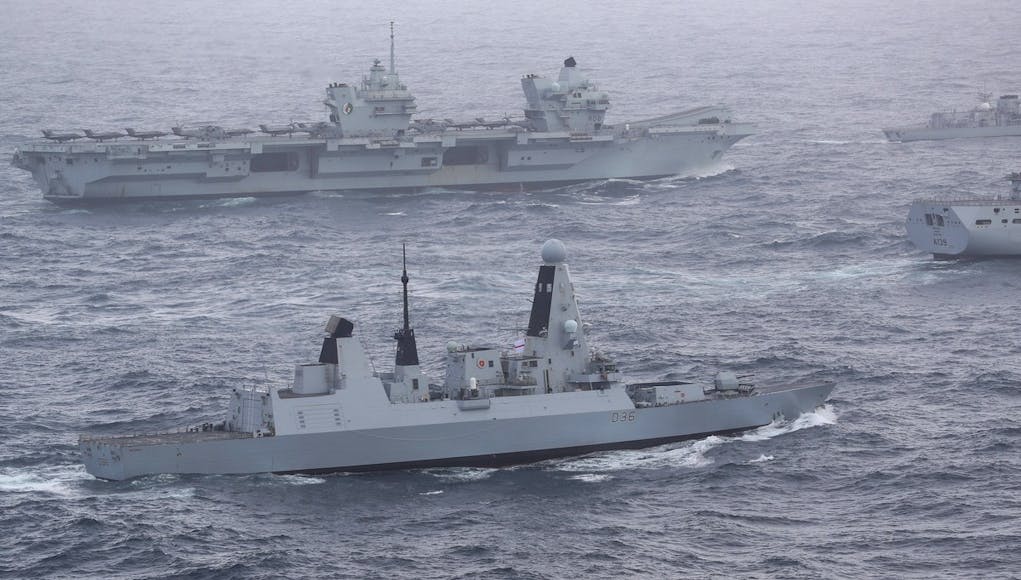

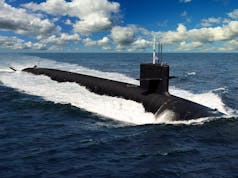



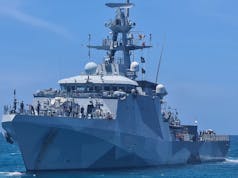





In retaliation from Scotland?
During these scenarios do they work against just the 1 missile, or do they plan against multiple missiles all at the same time and from different directions?
They simulate many different profiles. And they will get more complex as the exercise unfolds, and different aircraft types will play ‘red air’
Thanks Robert. The reason I asked is events in:
Syria
Libya
Armenia
have seen the Turks use mass drone tactics in which to kill the other fellow. In the latter, there are plenty of videos across social media of suicide drones. A small boat with an iso container on board could sent out numerous suicide drones
Making life very hard for somebody on a boat.
The RN practice for all eventualities, and swarm attacks are very much part of the training package these day’s, especially for vessels heading to the gulf region. The threat from small fast vessels and drones is taken very seriously, and there are many tactics to counter them
We currently have little defence against a swarm attack nor does the other guy
It would be interesting to know the detection range against sea skimming targets without AEW. If you are trying to counter a stealth anti ship missiles moving at 700mph at sea level you won’t have a lot of reaction time. If it is moving at mach 3 would there even be any reaction time if it is only spotter 50 miles out.
The bad guys have to first find the vessel before firing anything at stealth mach 3. No easy task.
As demonstrated during the falklands, finding a ship is pretty easy as the sat calls are trackabls. Russians again did it during the Iraq war
Not when you go electronically silent. Plus the vessels we lost during the Falklands were all pretty close to shore, open ocean is a different story.
Argentina tracked the way before they got close to shore.
Ships don’t move that fast and so if you can track the rough position its enough to then find them.
It doesn’t work as simple as that Steve.
HMS Sheffield was out on picket duty in the open sea, up threat of the carriers, and Atlantic Conveyer was out at sea with the task group also.
The carrier group was tracked well before the picket line was formed, which is why the passenger jet was flown over it as it crossed the Atlantic.
The mast height on the T45 is ~ 35 metres, which yields a radar horizon for an object flying at 2 meters above sea level of ~ 30km.
An approaching missile at Mach 3 at sea level (~1000 m/s, at 2m above wavetops) would give a theoretical warning time to impact of 30 seconds, assuming it was detected as soon as it crosses the radar horizon and it was aiming for the T45 and not another target.
The T45 of course would want to destroy the missile asap as even a destroyed missile travelling at that speed would have enough momentum to hurl debris and burning propellant forward with high velocity which could still damage a ship.
Of course if you’ve got a Crowsnest in the air the odds are much improved…if…
I guess we don’t know how many rotations a minute the Sampson does and how many seconds the missile could be in the dark side in the worst case scenario, i am guessing atleast a couple lowering that 30secs a tad.
Because the Samson is dual pane and Aesa nowhere should be without radar coverage for more than 0.5 seconds. The bigger issue is artisan which is a single pane and pesa so the beams cannot be actively steered meaning the blind spot is a lot longer. It was stupid not to put Samson in the carriers.
30 seconds doesn’t leave a huge amount of time to counter especially if there is more than 1 approaching. The best counter is to take them out before they are launched.
A triangular array of AESA panels would be a step up from Samson. Only one sided panels would be needed! Each would give 120 degree view of the airspace.
Conventionally, four arrays and not three would be used to provide a comfortable overlap in azimuth scan between each array (see, e.g., APAR).
In addition to requiring more power, the arrays would need to be mounted lower on a wider section of the mast, which is the sacrifice of an “all seeing” arrangement: when dealing with sea-skimming targets you may end up seeing them even later because of your reduced radar horizon. The T45 has an unparalleled radar horizon at the surface because the SAMPSON is at the top of the mast.
Additionally, should an array fail, the SAMPSON will still provide 360º degree radar coverage, even if it will be at a reduced refresh rate. A ship with fixed arrays will have blindspot (less of a concern with a rotating wide area search array, but still).
Artisan isn’t a traditional PESA – it’s software driven and so has some features that are more akin to an AESA (hence the confusion that prevails on the web about whether or not it is in fact an AESA radar).
Additionally, given that the aircraft carriers currently do not possess any form of SAM and, at the most, may be equipped with Sea Ceptor in the future, it seems reasonable to have saved on the expense of fitting SAMPSON, which was really designed for AAW ships like the T45.
You can calculate it knowing the height of the T45’s radar, height of the missile and distance to the horizon.
Anyone have an idea on how the air attack faired. I have the feeling that the CSG won that battle.
I wonder if the SNP are still shouting that they have no warships in Scottish waters?
They will of course now be complaining about there being too many.
All good stuff apart from Cobham. If we require an aggressor Sqn (and we do) why not just let that Sqn be operated by the RAF or RN. Same aircraft, same costs only Cobham won’t be called up if it hits the fan so it’s a false economy.
We used to. 101 Squadron.
Outsourcing that was a mistake.
Steve.
The RAF Aggressor unit is No 100 Squadron at Leeming, still in business.
101 was a VC10 squadron and now operates Voyager.
Cobham and 100 provide differing types of aggressor services.
Even with their vast resources the Americans also contract out aggressor squadrons. A company like Draken International will buy lots of used jets from many places which gives great variety for training. They currently have over 70 jets, not a bad number for a private company.
Yeep, watch some Drakan aircraft on planefinder.net over the Southern North Sea
Often wondered what they were.
As for Chobam, I think it would be better if there was a ded icated RAF sqn with aircraft types from diffrent counties working as the attacker. Every aircraft has a diffrent skill so it would be useful, Chobham is a good company but using private jets in the strike role is like using a Ford on the F1 track
“hand-operated machine-guns and SA80 rifles”
How’s your luck
Waste of time against jet aircraft or missiles – not a prayer.
I don’t think GTA MANPADS would be much use in a marine environment as too much pitch and yaw.
That being said I do believe in Ceptor and Aster as mature functional systems.
I sort of believe in R2D in some applications – it would certainly work against Excocet type threats.
You would think that at the terminal phase, manpads with IR trackers would in theory could be effective.
Many years ago I was peripherally involved in testing various MANPADS against various targets.
Invariably it worked OKish on glass like sea in good weather. Apart from one system that couldn’t hit a barn door at point blank range.
Once there was a higher sea state or any geometric or weather complicity to the interaction they really couldn’t cope. And success % dropped radically.
There is a reason why maritime point defence weapons are expensive: they are quite complex and designed to perform in difficult environments.
That isn’t to say you can’t maranise a MANPAD – but thinking that you are going to plonk Starstreak, or whatever, onto the hanger roof and get something as effective Ceptor……also Starstreak doesn’t not have a proximity fuze so needs a direct hit.
You would be much better off keeping ships in groups under a Ceptor umbrella although that does then give you a bigger effective target.
I would guess that if a missile came into range of a MANPAD, then the main missiles have failed and throwing anything you have at the missile is worth it, even if the chance of hitting is close to 0.
Hope the Brits get an AEW capability soon for their CV.
I have just seen a photo on an article about the USN Fleet.
https://www.thedrive.com/the-war-zone/36931/everything-we-just-learned-about-the-navys-dubious-path-to-a-500-ship-fleet
3 ABs sailing around and only one has Phalanx fitted.
2 have no Nukla Decoys fitted ( Between the funnels)
Not a Harpoon Launcher in sight either.
Shock Horror!
So the RN is not the only one who does FFBNW.
But at least these 3 ABs are flight IIA where they changed the design and fitted a hangar…Who ever though a Destroyer/Frigate did not need organic air onboard needed a slap!
From what i read one of the UK Admirals stated that Harpoon is now ineffective against any form of reasonably air defense. Its still the best we have (his statement at the time was ‘better than nothing’) but not sure if the US has other options now.
The US still uses harpoon, but the block 2 variant vs the UK’s block 1C. Better data links and tracking, plus other features. The US also has Naval Strike Missile’s on their LCS’s. And soon will have vertically launched LRASM’s as the primary anti ship missile for the next 15+ years.
I would love to see an LCS in the North Sea in Autumn /Winter. But then again it would be lucky to make it over the Atlantic without breaking down.They are so unreliable they make the T45 of 5 years ago look positively good!
To my knowledge NSM is only fitted currently to one vessel and thats a west coast trimaran version. Nothing yet on the east coast mono hulls although that may change.
LRASM VL is i beleive the way to go longer term but an upgrade to Harpoon Block 2 would be a good interim fix.
Hi GB,
Here’s the latest from USNI on the new Battleforce plan for the USN. Looks as thought the dam has burst and dedicated light carriers will be included in the fleet mix if it is realized.
https://news.usni.org/2020/10/06/secdef-esper-calls-for-500-ship-fleet-by-2045-with-3-ssns-a-year-and-light-carriers-supplementing-cvns
Cheers!
That would seem a tall order given their budget issues and maintenance problems. They can’t maintain their existing fleet let alone that many more hulls. I would imagine they are pushing Congress for more than they really want but the numbers involved are still eyewatering, 60 to 70 new combatants based on the new frigate design, another 10 Virginia Class boats, a new class of light carrier. It seems a little ‘fantasy fleet’ to me.
With Trump in power and China being seen as a major threat to the US position in the world, i suspect they will get the budget.
Maintenance is a huge issue. I work on a lot of USN vessels . They have been worked hard with little if any breaks in the operational cycles.
From my perspective the RN maintenance regime and support on the coal face and second line is far far better than the USN organisation. The RN go out and hunt for defects prior to maintenance or refits. The USN always seems surprised when you start finding defects hidden under defects that they did not know about or never previously found.
The RIM-66M has an anti ship mode doesn’t it? The MK41 VLS also fires LRASM but I can’t find anywhere that mentions the ABs carrying them.
Interesting though, there is often an assumption on this site that the USN sail armed to the teeth but apparently that isn’t quite true.
The AB batch 1 have harpoon but no hanger or helo
AB Batch 2 are the same.
AB Batch 2 A have the hanger but no harpoon.
Batch 3 no harpoon, have a hanger and more modern electronics.
With the removal of Anti Ship tomahawk years ago the ABs are light on surface warfare. They may have fitted Standard 6 which has a surface attack capability but its more of a stop gap and they do have a 5inch gun.
In addition not all of the ABs have a towed array. Bow sonar yes but no towed array.
The SPY 1 radar is PESA and only with SPY 6 only now being fitted to the latest ABs under build and programmed to be retrofitted to existing vessels will the USN get a AESA radar. A T45 Sampson is AESA so it could be said is years ahead of the USN with regards to radar fits. Look at the upper deck of an AB. Radar directors Fwd and Aft are needed for the missile systems . No directors required for T45 or T23. The USN is again catching up to the RN with active homing Standard 6 and Evolved Sea Sparrow which is coming online and is now an active homer.
Machinery wise the ABs are a similar fit out to T42 and T22s. GTs driving the shafts via gearboxes. No electric drive and DGs driving the electrical load.They tried to bodge an electric drive on one of them but gave it up as a bad idea. Speaking with an engineer who worked on that electric drive project he explained that they simply have no margin left in the design for any sort of growth. Trying to stick an electric motor on the existing shaft line was a bad idea from the start. i must say that working in an AB machinery space is like going back in time to a T22!
So the grass isnt always greener on the other side of the pond.
Has the phalanx system ever hit anything in a real combat situation?
What a disposition to have. Who would be foolish enough to make even a simulated attack on the most advanced battle group ever to be assembled.